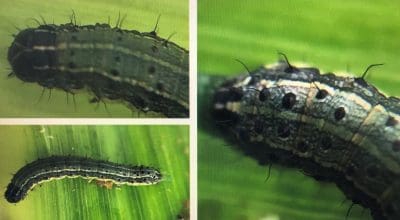
THE exotic pest, fall armyworm (FAW), which arrived on Australian shores in February and has since spread across the north of the continent and as far south as Maitland in New South Wales and Gingin in Western Australia, poses a substantial threat to crops.
Entomologists and agronomists have been grappling with how best to control the outbreak and manage the pest in-crop.
In the following Q&A from a recent GRDC Grains Research Update webinar on FAW, Queensland Department of Agriculture senior entomologist, Dr Melina Miles, and Nutrien Ag Services senior agronomist in the Burdekin region of north Queensland, Brent Wilson, respond to questions posed by webinar participants.
The questions have been broadly grouped into themes below:
Identification and life cycle
Question: Does what the larvae is feeding on change the colour of the grub?
Response (Melina Miles): That does seem to be the case. In our trials we are seeing much greener larvae in sorghum than we see in corn. US info suggests that colour is also influenced by how exposed the larvae are in the crop. Larvae in our laboratory colony are very pale, but when we transfer them to live plant material (corn, sorghum) they change colour within a couple of days.
Question: Could Melina describe the life cycle of FAW. how many days, temperature relationship etc.
Response (Melina Miles): Great resources available via the GRDC FAW portal https://grdc.com.au/resources-and-publications/resources/fall-armyworm
Pulse crops
Question: In mungbean crops, is the FAW fairly exposed compared to the whorl of a corn crop?
Question: How do soybean fair?
Response (Brent Wilson): To date, I have only sprayed one mungbean crop for FAW. The larvae were feeding on volunteer corn within the crop and transferred onto the mungbeans once a Group A herbicide had been applied. The resulting insecticide application worked extremely well. To date, I have not had to treat for FAW in soybeans.
Other crops
Question: Any experience of FAW on rice?
Response (Brent Wilson): To date, we have not observed FAW in rice crops in the Burdekin region.
Alternate hosts (weeds)
Question: Any favoured weed species that overwinters it?
Question: What about Sorghum halepense as a weed host? Would that have an impact on populations or AWM?
Response (Melina Miles): To date, only limited survey work has been undertaken to determine the range of non-crop hosts being utilised by FAW in Australia.
Predators and beneficials
Question: Are you seeing any predator activity?
Question: Any potential for parasitoids?
Question: Do we have natural control agents in Australia already, or will we need to introduce them?
Question: Is anyone monitoring current natural predator or parasitoid levels across northern Aust? Will these natural enemies build up in sufficient numbers rapidly enough to protect crop production?
Question: Do you think ecological engineering has good potential to manage FAW by enhancing natural enemies activity? Is there any research in this area?
Response (Melina Miles): It was anticipated that many of the parasitoids and predators that impact other noctuids (e.g. native armyworm, helicoverpa, loopers) would also use FAW as a host.
Collections of FAW eggs and larvae are being made from across the current infestation zone.
Pleasingly, a number of larval parasitoids have been identified from FAW. Cotesia spp. are particularly evident in FAW populations in southern Queensland, northern NSW. Very high levels of parasitism (and control of FAW) have been recorded in many maize crops in these regions.
Microplitis and tachinid parasitism have also been recorded at lower levels. Egg parasitism has been more difficult whilst FAW population density is low, but in north Qld there is evidence of egg parasitism but the species have not been identified. It is likely that Trichogramma and Telenomus species will impact FAW, there may be others.
Cotesia spp. are most often seen attacking native armyworm species in winter cereals, cabbage white butterfly in canola and other brassicas, and loopers. The 2020 winter has been relatively mild, and the wet conditions in much of NSW has probably been conducive to the build up and maintenance of these susceptible noctuid caterpillars and their parasitoids.
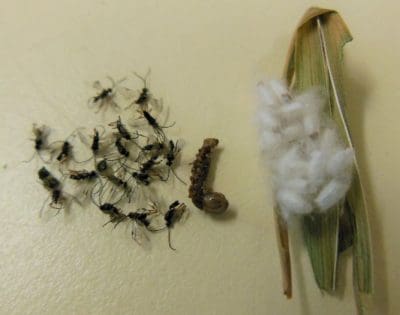
From left to right: Cotesia wasps emerged from cocoons, caterpillar cadaver, Cotesia cocoons that were attached to the caterpillar prior to wasp emergence.
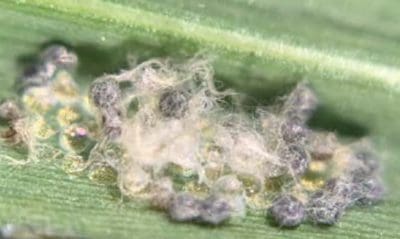
FAW egg mass with parasitised eggs (black). Larvae have hatched, leaving just the parasitised eggs in the egg mass. Parasitoids (in this case Trichogramma sp.) emerged around a week later.
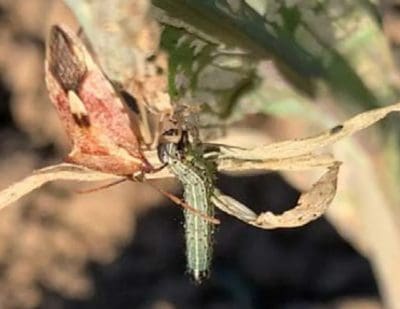
In terms of predators, the spined predatory shield bug (Oechalia schellenbergii) has been the species most commonly observed attacking FAW larvae.
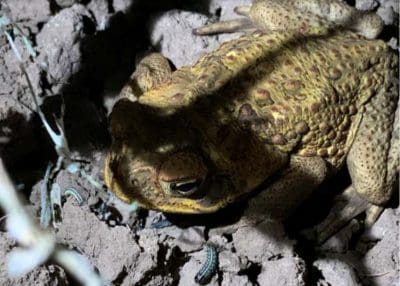
Other predators – well, it is Queensland after all!!
These promising developments highlight the importance of a conservative approach to the use of insecticides. It is likely that natural enemies will be able to control FAW in entrenched (hidden) feeding sites more effectively than foliar insecticides.
Rotations and farming system impact
Question: Will corn growers continue to plant corn in the future?
Question: Silage and cattle forage, maize vs forage sorghum. Would you grow one over the other this summer or how would you manage these crops?
Response (Brent Wilson): Corn producers in the Burdekin have indicated that they will continue to grow corn crops, however due to the damage recorded in popcorn crops, many producers have indicated they would most likely not grow popcorn again. We have observed high levels of FAW activity within forage sorghum rotations, very similar levels to maize crops. To date we have not spray insecticides within forage or silage rotations.
Yield and quality impact
Question: What was the effect on maize quality specs?
Response (Brent Wilson): To date we have had issues with damaged grain and discoloured grain resulting in further grading losses over and above paddock yield losses, especially in popcorn and to a lesser extent in grit corn.
Question: Do you think yield losses are comparable with losses seen from leaf damage from hail?
Response (Melina Miles): Hail causes defoliation, but typically the impacts of hail in a crop are confined to just one event. The challenge with FAW is that the defoliation pressure is continuous throughout the crop (in North Qld) – almost like weekly hail events! If FAW infestations further south are more episodic, then hail-induced defoliation might be a good reference point.
Question: I have understood application of insecticides at tasselling. However, doesn’t it have considerable yield reduction by its attack at the vegetative state?
Response (Melina Miles): Both maize and sorghum have the capacity to compensate for some defoliation, probably significant defoliation – particularly if it occurs as a discrete event during the vegetative stage. The impact of continual defoliation on yield potential is less well understood.
Question: Any comments on maize quality rather than yield?
Response (Melina Miles): FAW appear to cause significantly more damage to the side of the cobs than does helicoverpa. Consequently, the risk of secondary bacterial and fungal infection is heightened. It is unclear whether the risk of mycotoxin contamination will be elevated as a result of FAW feeding damage.
Scouting and thresholds
Question: Do you feel you have developed an effective scouting and control protocol?
Question: Have you developed any thresholds yet?
Response (Melina Miles): No.
Question: Did you assess the yield loss? on what specific stages of corn mostly do damage?
Response (Brent Wilson): All growth stages are susceptible to damage by FAW in corn.
Question: What method have you guys used for scouting crops?
Response (Melina Miles): Visual checks of plants, looking for both eggs and larvae. Pheromone traps near crops indicate relative level of moth activity in the local area.
Question: How have you been assessing the levels of FAW infestation? Have you been doing intensive visual checks early in corn crops aimed at finding eggs and/or young larvae or just checking for signs of feeding?
Response (Brent Wilson): We use intensive visual checks to determine both percentage infestation and individual larvae numbers per plant. Signs of feeding are just that, they don’t represent or indicate absolute numbers.
Question: I understand the logic of delaying spraying in veg stage. Curious as to what larval stages are being sprayed during tasselling? Are they late instars or a wide range because of multiple egg lays over that veg period? Concerned of permits with rate ranges as may lead to lower rates being used on larger larvae?
Response (Brent Wilson): At tasselling we are typically spraying a wide range of larvae due to overlapping generations/egg lays.
Control options
Question: Are Bt genes effective against FAW?
Response (Melina Miles): It is likely that there is resistance to some Bts, but possibly some that are effective. CSIRO has looked at this question through the GRDC investment, but results are not yet publicly available.
[Subsequent to this, the following has been released: https://grdc.com.au/news-and-media/news-and-media-releases/national/2020/november/early-research-to-guide-insecticide-use-for-fall-armyworm
Question: What is NPV virus like on FAW?
Response (Melina Miles): Helicoverpa NPV (Vivus) is not effective on FAW. Fawligen is specific to FAW, but not available in Australia.
Question: Has there been any efficacy work done on other bio pesticides, other than NPV (Vivus). Such as SERO-X ?
Response (Melina Miles): Not at this point.
Question: Indoxacarb or Chlorantraniliprole, which spray should be used first?
Response (Brent Wilson): I use Chlorantraniliprole during the critical establishment period (<V4), then I use Indoxacarb prior to tasselling.
Question: Has any virus or fungus been developed for control of FAW like NPV in heliothis?
Response (Melina Miles): Not in Australia at this point. The fungal pathogen Metarhizium rileyi (formerly Nomurea rileyi) has been observed frequently in crops on the Atherton Tableland. A commercial formulation of this fungus is available overseas.
Question: What crops overseas are they using as a trap crop?
Response (Melina Miles): Most work in this area has been done with smallholding production systems in mind. Approaches include (i) intercropping (legumes + maize), and (ii) a “push-pull” systems that include a repellent species (e.g. Desmodium spp) intercropped with maize, and an attractive species (e.g. Pennisetum/Brachiaria) planted as a trap on the crop edge.
Question: Any movement in fawligen virus reg in Australia?
Response (Melina Miles): Application for importation (QDAF/AgBitech) being assessed by AQIS.
Question: Best time to spray magnet with orientation with moon events?
Response (Brent Wilson): We have not observed any orientation with moon phases relative to FAW activity.
Question: Would methomyl spray have any effect on egg masses?
Response (Melina Miles): Targeting egg masses is challenging because they are often laid on the under surfaces of leaves. Methomyl is a highly disruptive and short-lived insecticide that would be very toxic to beneficials. It is also likely that FAW already has moderate-high levels of resistance to carbamate insecticides (and synthetic pyrethroids). The use of methomyl to target FAW eggs is not a recommended practice.
Question: Based on the FAW being predominately in the whorl of corn creating a target issue for insecticides has there been any Steward/Altacor etc. being applied through either lateral or pivot irrigation?
Response (Melina Miles): Application of these products through irrigation is not a registered use pattern.
Distribution
Question: How far south do you expect FAW to be a problem in winter cereals
Response (Melina Miles): It is hard to say what risk FAW poses to winter cereals. This is highly dependent on the pattern of infestation by FAW in the different regions. It is possible that FAW could be active in some regions when winter cereals are planted early, and when they mature late.
Question: How quickly is FAW travelling and is there any estimate on when/if it will reach the grain growing parts of WA?
Response (Melina Miles): Movement of FAW into new areas is most likely to occur in conjunction with significant meteorological systems that carry moths from northern regions in spring-summer.
Predicting the timing and/or frequency of these events is difficult. It is unlikely that FAW will persist year-round in WA grain-growing regions because of the cool conditions over winter.
Question: Potential hotspots along the eastern coast for future events? post a cold winter event?
Response (Melina Miles): Regions east of the Great Dividing Range through to southern Qld and northern NSW may see persistent FAW populations (e.g. Lockyer Valley, Qld).
Other
Question: Is area management plan for insecticide resistance feasible, if some neighbouring properties are organic growers? How to manage nearby sinks for build-up of FAW populations?
Response (Melina Miles): Insecticide resistance management will be vital to the long term management of FAW (and helicoverpa armigera). An area-wide (region-based) or even industry- based strategy with a high level of compliance would be even more effective in delaying the development of resistance. At present it is unclear what the sources/sinks of FAW are in the landscape – the role of crops and non-crop vegetation.
Question: What is the market saying about moving into GM corn in Australia?
Response (Melina Miles): A challenging proposition. Currently, the major importer/s of Australian maize do not want GMO maize.
Question: Are genetic studies showing Australia had one main incursion of FAW or is Aust getting numerous subsequent incursions from overseas moth movements?
Response (Melina Miles): CSIRO, through a collaborative RDC/ACIAR/private investment is analysing the population data from the Australian and overseas populations. It is possible that there will be ongoing incursions of FAW, and this could be monitored through seasonal collections of FAW populations from across Australia.
Source: GRDC
Other resources:
Recording: A recording of the GRDC Grains Research Update online held last week is available here
GRDC Update paper: ‘Fall armyworm: what threat does it pose, and what tools do we have to manage it?’ (Melina Miles)
The Beatsheet Blog (www.thebeatsheet.com.au) – Find information on FAW in the “Key Pests and Management” page. Includes information on identification, webinars, pheromone trap network data. From the “Resources” page, you can access the DARABUG2 development model. This tool provides predicted development rates of FAW (and other species). Useful for calibrating yourself in terms of the rate of development of eggs, larvae and pupae.
The GRDC Fall Armyworm portal provides access to a range of important information for Australian grain growers: https://grdc.com.au/resources-and-publications/resources/fall-armyworm
A list of current permits for FAW insecticide options is searchable at the APVMA PUBCRIS portal: https://portal.apvma.gov.au/permits
Follow @bwilson_71 (Twitter) for insights into an agronomist’s first-hand experience with FAW in north Qld.

HAVE YOUR SAY